| |
Birding Trip report from Fuerteventura
December 8th to
15th 2009
A group of 5 members of the Tolka Branch of Birdwatch Ireland flew from Dublin
to Fuerteventura on 5th December with Aerlingus. The group included Dermot McCabe, Lorraine Benson, Heather Quinn,
Sean Kingston and myself John Fox. Flight Time is about 4 hours and cost €180 return (incl taxes). We stayed in an apartment
in Corralejo which had the potential to sleep up to 14 people. The apartment plus the rental of a 9 seater VW people carrier for
the week cost about €1250. Apartment included a swimming pool, Jacuzzi outdoor seating area and sun terrace on the roof. It was located
about 15min walk from the centre of Corralejo.
Our constant companions on the trip were: “The Birdwatchers Guide to The Canary Islands” by Tony Clarke and David Collins which was produced
in 1996 and is an excelent guide to the Island but in need of a little updating in 2009, and the AA Island Map FUERTEVETURA 1cm= 500m (Scale 1:50,000).
Tuesday 8th December 2009
We went into Corralejo at about 11.00pm for dinner. The town was very quiet and our restaurant
was surprisingly inexpensive for very good food.
|
Day 1: Wednesday 9th Dec 2009
From our apartment Lorraine spotted a lone Barn
Swallow. Yellow-legged Gulls were also seen flying over.
Quite late in the morning we travelled south to our fist birding site;
The Reservoir at Los Molinos, said to be the largest body of
freshwater on the island and one that never dries up. It is located
south of the village of Tefia and is close to the West coast. En
Route, from the car, we saw several (Common) Kestrel and Southern Great Grey Shrike perched on
the telegraph wires. Stopping on the road which leads to a goat farm
near the Reservoir we spotted a Blue Tit of the Sub species Parus caerulus degener.
|
|
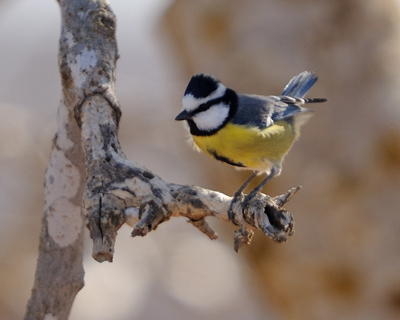 |
| |
|
Blue Tit (Parus caerulus
degener) |
A Goldfinch was also seen by some of the group at this location. Close
to the Goat Farm we found our first
Spectacled Warbler a small flock of 15 to 20 Spanish Sparrows.
Over 30 Berthelot’s Pipits were foraging at the Goat farm affording
very close views. One of the Pipits was ringed.
Three
Ravens flew overhead which were the first crows we saw on the Island. In the fenced boulder field North of the goat farm among the Goats to our surprise were up to 20
Ruddy Shelduck. None of our group had ever seen ducks in such a desert like environment before it felt quite surreal.
Five Black-bellied Sandgrouse were also spotted grazing among the Goats and a single
Lesser Black-backed Gull was perched nearby. A Buzzard and a
Kestrel soared briefly within view overhead sending the ubiquitous
Barbary Ground Squirrels scurrying for cover. On arrival at the Reservoir we were surprised and disappointed to discover that the “largest body of fresh water on the island which never dries up” had indeed dried up. Not even a puddle was evident. As a result, the hoped for and expected waders did not materialise.
The second birding site we visited was the area in and around El Cotillo, which is on the North West Coast to the West of Corralejo. In the harbour at Cotillo we found our first waders, 13
Turnstone. Berthelot’s Pipits were seen along the coast road in the Village.
|
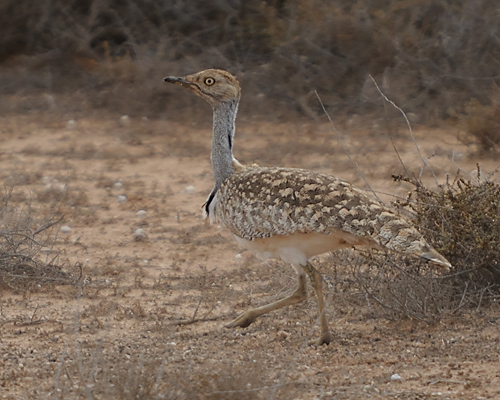 |
|
We headed South from the Village past the Fuerta Del Cotillo (a small round tower) out onto the dry coastal stony plains which have a reputation for being good for Houbara Bustard, one of our target birds. Scanning this area for about thirty minutes with bins and scopes we spotted our first
Hobara Bustard which was immediately communicated to the others in the group using our walkie talkies. Soon the whole group had sight of the Bustard much to everyone’s delight. Shortly after that a
Cream-coloured Courser emerged from the Scrub quite close to our group affording lovely views to all. Spectacled Warblers, Southern Great Grey Shrike, Berthelot’s Pipit, Collared Dove and Feral pigeons were also seen. Later 2 Stone Curlews were flushed from the scrub and flew back towards the village which despite some searching were not relocated.
|
|
Houbara Bustard (Chlamydotis undulata) |
|
|
|
We returned to our accommodation well after dark happy that on day one we had seen several of our target birds. Feeling that we could relax a little we took another trip to Corralejo for dinner and late night drinks
followed.
|
|
Day 2: Thursday 10th Dec
After another late morning start we travelled South to the town of La Oliva where Southern Great Grey Shrike and Kestrel were again seen.
From the town we travelled South about 1km where we came upon an area where fresh water was being used to irrigate a small area of fenced crops.
It stood out as a strikingly green field in an otherwise red brown desert landscape. Small pools of water in the green field attracted a small mixed
flock of 10 Trumpeter Finch and a few Linnet. Up to 10 Lesser Short-toed Lark, 8 Berthelot’s Pipits, 2 Hoopoe
and a single Corn Bunting had also come to the area to drink. 3 Cream-coloured Courser were also found nearby where they were observed
probing in the red soil for food. Heading West from La Oliva towards La Caldereta and on to the East coast further
Southern Great Grey Shrike and Ruddy Shelduck were again seen.
|
|
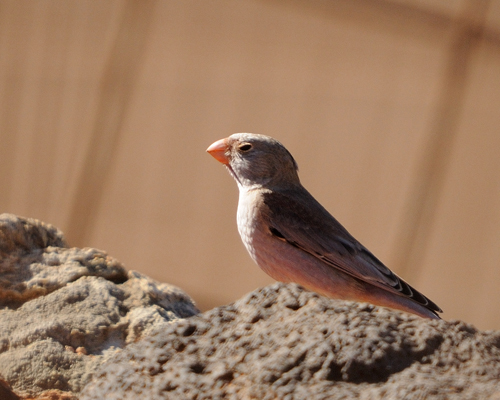 |
|
|
Trumpeter Finch (Becanetes
githagineus) |
From the East Coast we turned West again for the Village of Guisgey which is located in a spectacular river valley. Here we found another of our target birds and Fuerteventura’s only endemic,
the
Fuerteventura Stonechat. There were up to ten birds present in the village area and others further West along the Valley. We followed this road which became a track as far West as possible but eventually we turned back as the terrain became too much for our VW. Along the Valley we saw further
Spectacled Warblers and 2 Buzzards in the valley below us. Once again the
Barbary Ground Squirrels were everywhere to be seen.
Back on the East Coast we stopped for a late lunch at a beach
cafe in Puerto Lejas. A seafood feast of tapas followed which was enjoyed by all. From the
cafe we had a good view along the coast where we saw Lesser and Greater Black-backed Gull,
Yellow-legged Gull, Whimbrel, Turnstone, Little Egret and
Sandwich Tern. Spanish Sparrows were also present in the shrubbery near the
cafe. With the light fading we drove North on the East coast road through the National Park of sand dunes back to Corralejo. With more target birds under our belt another late dinner and late night drinks followed.
Day 3: Friday 10th Dec
We travelled South towards Betancuria (the ancient historical capital) via the hairpin roads up to Mirador Moro Velosa which is at an elevation of about 670m. A small museum and cafe have been built here and afford superb views of much of the Island and beyond to Lanzarote.
Berthelot’s Pipits were feeding in the museums garden, Collared Doves were in the car park and on the drive down to Betancuria village
Buzzards and Ravens were seen in the skies taking advantage of the up drafts in the strong breeze. The area around Betancuria Village is quite lush and there is a small sewage works to the South of the village. In and around the village we had a
Sardinian Warbler, Spanish Sparrows, Ravens, Kestrels,
Blue Tits (Parus caerulus degener), an Olivaceous Warbler
(seen by Lorraine only), Berthelot’s Pipits, Great Grey Shrikes and a single
Song Thrush.
Travelling further South to Vega De Rio Palma another lush area we were again disappointed to discover that the reservoir lake was dry. From the point where the
road terminates near the small wind pump we had superb views of a Southern
Great Grey Shrike which seemed oblivious to our presence. Sardinian
Warblers, Berthelot’s Pipits and Ravens were also present in the area.
Retracing our route to the GC-620 we turned South again towards Pagara and lunch at Casa Azita de Pagara where Kid Goat was the order of the day. Super food but quite expensive by Fuerteventura standards. A
Blackcap was heard calling near the Restaurant but was not seen. Collared
Doves and Spanish Sparrows were also present in the village.
Making or way back to the North on the FV-20 close to the round-a bout intersection with the FV-225 we noticed the river valley of Barranco de rio Cabras which contained the first running water we had seen on the trip, worth a look we thought. Taking the southerly exit from the round-a bout followed by a fork to the left we soon were along the riverbank where we parked. Here we had a
Little Ringed Plover, Grey and White Wagtail, a pair of
Laughing Doves, a Little Egret, Chiffchaff and two
Ruddy Shelduck. A Moorhen was heard but not seen. With the light fading fast we headed for home but decided to return in the morning as we felt this river area might be more productive in the early morning. After a dinner of dreadful take-away Pizza and home made, but somewhat delicious cocktails, an early night was decided upon in anticipation of our early start in the morning.
Day 4: Saturday 12th Dec
There was a considerable fall of rain over night but we were on the road by 6.30am well before dawn and arrived back at Barranco de rio Cabras at first light. The area had become quite muddy and fine rain was still falling. The site did not deliver all we had hoped for but we did see a single
Moorhen, Snipe, Laughing Dove, Chiffchaff and a
Ruddy Shelduck. Leaving the site we felt that many of the bird had perhaps left this area as water on the island could now be more widespread.
Heading to the East coast we visited Las Salinas the site of a salt pan and a small salt museum. It is located about 2km below the airport de Fuerteventura . Along the coast at this location we had
Turnstone, Yellow-legged Gulls, Lesser Black-backed Gulls,
Whimbrel and a Grey Heron.
Heading further South we arrived at La Lajita which is described in the tourist brochures as an Oasis Park but is in fact a zoo, raptor centre etc. We had some brunch in the cafe and explored the very vegetated area around the Park. Here we had a pair of
Red Vented Bulbul flying free, presumed to be escaped birds. The only other species seen here were a
Blackcap and Spanish Sparrows.
Continuing South along the East coast we arrived at Playa de Sotavento de Jandia a popular Naturist beach resort. From the car park on the cliff top above the beach we were able see over 20
Kentish Plover, 1 Ringed Plover, 1 Dunlin and about 20
Sanderling mixing it with the naturists below on the beach. There were perhaps more birds on the beach but I think many of the group lost focus at this location. Above the beach we had a lovely fly by of two
Red Rumped Swallows a pair of Collared Dove and a Spectacled Warbler was foraged in the scrub. At a second beach location about 1km further South West also described as Playa de Sotavento de Jandia we walked out onto the beach where we found 3
Spoonbills, and surprisingly a Yellow Billed Stork. We also found
Greenshank, Kentish Plover, Dunlin, Yellow-legged
gulls, Lesser Black-backed Gulls, and a Southern Great Grey
Shrike.
The next location we stopped at was Playa de Matorral in the extreme South of the Island. Its a busy costal resort town with lots of tourist activity. Here we found 8
Monk Parakeets feeding along the promenade. Two Cattle Egrets and
Spectacled Warblers were seen in the scrub in front of the promenade near the light house.
Returning North a solitary Egyptian Vulture was seen briefly soaring high in the mountains by Lorraine from the car. We made another stop on the West coast at the sea side Village of Los Molinos which is no more than a small cluster of houses at the mouth of a dry river. The only addition to our species list at this location was a solitary
Coot swimming with some domestic ducks in a small pool at the mouth of the dry River beside the sea. Other birds seen in the area were
Yellow-legged Gulls, Little Egrets and 1 Spectacled
Warbler. For our final stop of the day we returned to the area we had visited on the first day at Embalese de los Molinos. However we approached the dam from the North on this occasion. Roads were generally better from this direction. We were delighted with 3
Fuerteventura Stonechats on the barbed wire which were the only birds seen here on this occasion as the light faded.
Day 5: Sunday 13th Dec
Returning to the El Cotillo Area for the second time and the plains to the South of the village we had a pair of
Black-bellied Sandgrouse and a nice flock of about 40 Short-toed
Lark which were located by their constant chatter as they fed in an area of scrub.
Barthelot’s Pipit were also again seen at this location.
|
|
We also visited the area to the North of
the village near the Lighthouse where we had more
Kentish Plover, Ringed Plover, Yellow-legged Gulls
and a few
Sandwich Terns fishing in the surf to the West of the Lighthouse.
Travelling North East along the coast we arrived at El Majanicho another sea side village where we had our first
Common Sandpiper together with a Whimbrel, a few Turnstone and
Sanderling. We lunched at the town of Lajares where the best bird were
Ravens. After lunch we headed South to La Oliva on the FV-214 and then went East on the FV-102 to the Puerto Lajas area and took a track down into the Baranco de Tinojay where we had views of 3
Hoopoe, 3 Southern Great Grey Shrikes, Spectacled Warbler and
Ruddy Shelduck. Returning to the FV-102 and turning North on the FV-1 we entered the Parque Natural de Corralejo once again. Stopping where the road was close to the sea we had our first
Grey Plover together with Kentish Plover, Sanderling,
Sandwich Tern and Yellow-legged Gulls.
|
|
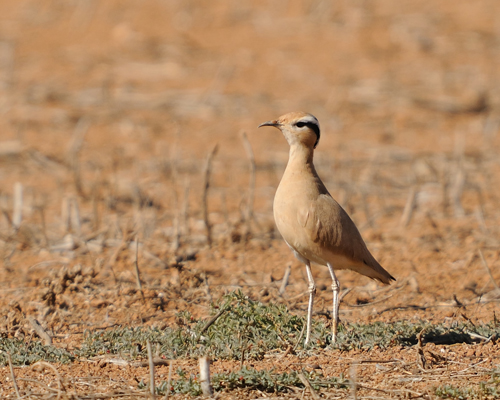 |
| |
|
Cream-coloured Courser (Cursorius cursor) |
|
With 56 species by now under our belt we decided to hit the town hard that night. After much good food, cocktails, wine, beer and dancing, we returned home weary at about 2.30am for badly needed sleep.
Day 6: Monday 14th Dec
By 11.30 the three of us that were up, awake and fit to go birding, headed back to El Cotillo. I personally was hoping to get some good photos of Houbara’s Bustard as views previously had been quite distant. With that in mind we headed out onto the plain South of the village again. The same flock of
Lesser Short-toed Lark were again seen and two Stone Curlews took flight. We decided to see how far we could travel keeping the coast to our right hand side. There are many dirt tracks on the plains but no real roads undaunted we carried on South. At the boundary to a farm we had super views of 3
Hoopoe probing in the soil and a pair of Southern Great Grey Shrike posed casually on the same stem very close to the car. A little further on near another farm we found a small flock of
Trumpeter Finch consorting with Spanish Sparrows. As we continued South the dirt tracks became more and more vague but we carried on in the hope of finding the elusive Barbary Partridge another of our target birds. The terrain was perfect habitat but we had no success. Along the way we had good views of
Kestrel, Barthelot’s Pipit and Spectacled Warbler from the car. We travelled South for several hours and having negotiated a difficult dry riverbed we realised we were approaching the town of Tindaya. When we were about ˝ Km from the town we were rewarded with superb views of a
Cream-coloured Courser followed immediately by even closer views of 2
Houbara’s Bustard. I managed a few decent shot making this foray into the unknown well worth while.
The three of us had a delicious late lunch in The Villa Verde Restaurant in La Oliva where we observed a
Laughing Dove on the roof of the restaurant before returning to base to check on our companions just before dark.
Day 7: Tuesday 15th Dec
Returning to Barranco de rio Cabras for one last look we were rewarded
with two additional species for the list; a Robin and a Stonechat.
Also present on the day were 2 Laughing Dove and a Spectacled
Warbler, 2 Snipe, a Ruddy Shelduck, 2 Buzzards
and 5 Ravens. A small flock of Spanish Sparrow were also
seen nearby. We then headed for Catalina Garcia which is 3km South of the
town of Tuineje on the FV-20. In a dried up river bed to the west of the
Road we had quite close views of a pair of Egyptian Vultures which
flew close to the car in a Southerly direction. To the East of the Road we
visited Catalina Garcia Lagoon which had also dried up. The best we saw
here were Yellow-legged Gulls and a Southern Great Grey Shrike.
We returned to our apartment packed our bags dropped off the car and flew home to a very cold and wet Dublin. The week had flown by all in all a great trip with a total of
59 species seen by the group. Three birds that we had hoped to see but missed were Plain Swift, Barbary Partridge and Barbary Falcon perhaps on the next trip.
|
| |
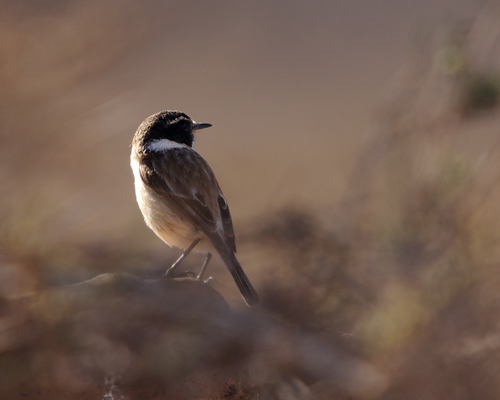
Fuerteventura Stonechat
(Saxicola dacotiae)
|
TOLKA 2009
Fuerteventura Systematic List
ec = Canary Islands endemic.
em = Macaronesian Islands endemic.
* = Canary Islands subspecies
** = Macaronesian Islands subspecies.
+ = Introduced species.
| No. |
Species |
Quantity |
Location |
| 1 |
Cattle Egret (Bubulcus ibis)
|
2
|
Playa de Matorral
|
| 2 |
Little Egret (Egretta garzetta)
|
6 |
various sites
|
| 3 |
Grey Heron (Ardea cinerea)
|
1 |
Las Molinas
|
| 4 |
Yellow-billed Stork (Mycteria
ibis)
{see Notes} |
1
|
Playa de Sotavento
|
| 5 |
Spoonbill (Platalea leucorodia) |
3 |
Playa de Sotavento |
| 6 |
Ruddy Shelduck (Tadorna
ferruginea) |
40+ |
various sites
|
| 7 |
Egyptian Vulture (Neophron percnopterus)
|
1
2
|
from FV56 N.of La
Lajita
FV20 S.of Tuineje
|
| 8 |
Buzzard (Buteo buteo insularum)* |
many |
from various sites |
| 9 |
Kestrel (Falco tinnunculus dacotiae)* |
many |
from various sites |
| 10 |
Moorhen (Gallinula Chloropus) |
1 |
Barranco de Rio
Cabra
|
| 11 |
Coot (Fulica atra)
|
1
|
Los
Molinos
|
| 12 |
Houbara Bustard (Chlamydotis undulata fuerteventurae)*
|
1
2 |
El
Cotillo
Near Tindaya
|
| 13 |
Stone Curlew (Burhinus oedicnemus insularum)* |
2
|
El
Cotillo
|
| 14 |
Cream-coloured Courser (Cursorius cursor bannermani)*
|
Several
|
El Cotillo,
La Oliva, Tindaya
|
| 15 |
Little-ringed Plover (Charadrius
dubius)
|
1 |
Barranco de Rio
cabras
|
| 16 |
Ringed plover (C.hiaticula)
|
1
|
Playa de
Sotavento
|
| 17 |
Kentish Plover (C.alexandrinus)
|
20+
|
Playa de Sotavento, Parque Natural de Corralejo, El
Cotillo
|
| 18 |
Grey Plover (Pluvialis squatrola)
|
1
|
Parque Natural de
Corralejo
|
| 19 |
Sanderling (Calidris alba)
|
10+ |
Playa de Sotavento, El
Cotillo
|
| 20 |
Dunlin (C.alpina)
|
few
|
Playa de
Sotavento
|
| 21 |
Turnstone (Arenaria interpres)
|
13 |
El Cotillo, few, Las Salinas,
El Majanicho
|
| 22 |
Common Sandpiper (Actitis hypoleucos)
|
1 |
El
majanicho
|
| 23 |
Greenshank (Tringa nebularia)
|
3
|
Playa de
Sotavento
|
| 24 |
Whimbrel (Numenius phaeopus)
|
1
|
El Majanicho, 1 Las Salinas, 1 Puerto
Lajas
|
| 25 |
Snipe (Gallinago gallinago)
|
3
|
Barranco de Rio
Cabras
|
| 26 |
Yellow-legged Gull
(L.michahellis atlantis)** {see Notes}
|
many |
various sites
|
| 27 |
Lesser Black-backed Gull (L.fuscus)
|
6+
|
various
sites
|
| 28 |
Great Black-backed Gull (L.marinus)
|
|
|
| 29 |
Sandwich Tern (Sterna sandvicensis)
|
few
|
Poerto Lajas, Parque Natural
de Corralejo
|
| 30 |
Black-bellied Sandgrouse (Pterocles orientalis)
|
5
2
|
Los Molinos Goat
farm
El Cotillo |
| 31 |
Rock Dove/Feral Pigeon (Columba livia)
|
abundant
|
|
| 32 |
Collared Dove (Streptopelia decaocto)
|
abundant
|
|
| 33 |
Laughing Dove (S.senegalensis)
|
2
1
|
Barranco de Rio
Cabras
La Oliva
|
| 34 |
Hoopoe (Upupa epops)
|
2
3
3
|
S. of La Oliva
FV102
Barranco de Tinojay
El Cotillo
|
| 35 |
Monk Parakeet (Myiopsitta
monachus)+
|
8
|
Playa de
Matorral
|
| 36 |
Lesser Short-toed Lark (Calendrella rufescens polatzeci)*
|
40+
10
|
El
Cotillo
La Oliva
|
| 37 |
Barn Swallow (Hirundo rustica)
|
1
|
Corralejo
|
| 38 |
Red-rumped Swallow (H.daurica)
|
2
|
Playa de
Sotavento
|
| 39 |
Berthelot's Pipit (Anthus berthelotii berthelotii)Em* |
abundant
|
|
| 40 |
White
Wagtail (Motacilla alba)
|
1
|
Barranco de Rio
Cabras
|
| 41 |
Grey Wagtail (M.cinerea cinerea)
|
1 |
Barranco de Rio
Cabras
|
| 42 |
Red-vented Bulbul (Pycnonotus Cafer)+
|
2
|
La Lajita Oasis
Park
|
| 43 |
Robin (Erithacus rubecula rubecula)
|
1 |
Barranco de Rio
Cabras
|
| 44 |
Canary Islands Chat (Saxicola dacotiae)Ec
|
15+
2
|
Road West of Guisgey
village
Embalse de Los Molinos
|
| 45 |
Stonechat(S.torquata)
|
1
|
Barranco de Rio
Cabras
|
| 46 |
Song Thrush (Turdus philomelus)
|
1
|
Betancuria
|
| 47 |
Blackcap (Sylvia atricapilla)
|
1
2
|
Pagara(Heard)
LaLajita Oasis Park
|
| 48 |
Sardinian Warbler
(S.melanocephala)
|
1
1 |
Betancuria
Vega de Rio Palma
|
| 49 |
Spectacled Warbler (S.conspicillata orbitalis)*
|
many
|
various sites
|
| 50 |
Olivaceous Warbler (Hippolais pallida)
|
1
|
Betancuria
|
| 51 |
Chiffchaff (Phylloscopus Collybita)
|
2
|
Barranco de Rio
Cabras
|
| 52 |
Blue Tit (Parus caeruleus degener)*
|
1
3+
|
Roadside nera Embalse de Los
Molinos
Betancuria |
| 53 |
Southern Grey Shrike (Lanius meridionalis koenigi)*{see Notes} |
many |
all areas |
| 54 |
Raven (Corvus corax) |
many |
all
areas |
| 55 |
Spanish Sparrow (Passer hispaniolensis) |
abundant |
|
| 56 |
Linnet (Carduelis cannabina harterti)* |
few |
La
Oliva |
| 57 |
Goldfinch (C.carduelis) |
1 |
Roadside near Embalse de Los
Molinos |
| 58 |
Trumpeter Finch (Bucanetes githagineus amanthum) |
10
6 |
La
Oliva
S. of El Cotillo |
| 59 |
Corn Bunting (Miliaria calandra) |
|
|
Notes: Taxonomy research is ongoing for these species,
Y-L. Gull is called Larus michahellis in the new Collins Guide,cachinnans being
Caspian Gull. Southern Grey Shrike is Great Grey Shrike in the same
work, while L.meridionalis is Iberian Grey Shrike. The subspecific
name "koenigi" in both systems is used for the Canary Island birds.
The status of the Yellow-billed Stork is not yet determined. There
has been a bird recorded at this site in 2000 and 2005.
Trip Report Author: John Fox
Fuerteventura Systematic List: Dermot McCabe
Photographs: John Fox
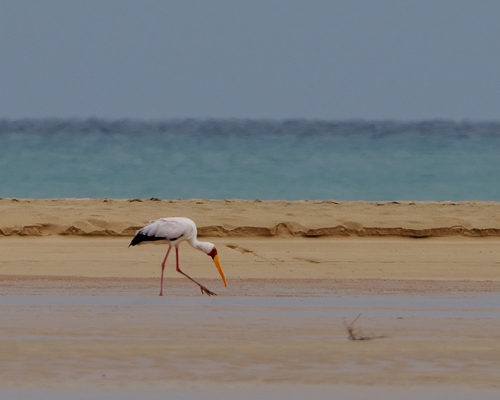
Yellow-billed Stork (Mycteria
Ibis)
|
|

